yeovil at war
home guard
The Local Defence Volunteers
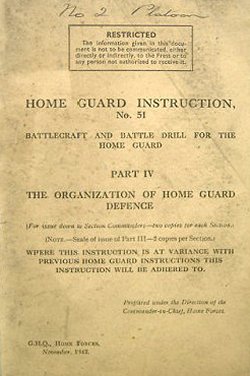 On 8 October
1939 Winston
Churchill, First
Lord of the
Admiralty, wrote
to the Lord
Privy Seal, Sir
Samuel Hoare
"Why do we not
form a Home
Guard of half a
million men over
forty (if they
like to
volunteer) and
put all our
elder stars at
the head and in
the structure of
these new
formations. Let
these five
hundred thousand
men come along
and push the
young and active
out of their
home billets. If
uniforms are
lacking, a
brassard would
suffice, and I
am assured there
are plenty of
rifles at any
rate".
(Churchill,
2005).
On 8 October
1939 Winston
Churchill, First
Lord of the
Admiralty, wrote
to the Lord
Privy Seal, Sir
Samuel Hoare
"Why do we not
form a Home
Guard of half a
million men over
forty (if they
like to
volunteer) and
put all our
elder stars at
the head and in
the structure of
these new
formations. Let
these five
hundred thousand
men come along
and push the
young and active
out of their
home billets. If
uniforms are
lacking, a
brassard would
suffice, and I
am assured there
are plenty of
rifles at any
rate".
(Churchill,
2005).
During the period of the Phoney War enthusiasm for a home defence force waned but, following the evacuation of the British Expeditionary Force from France in early May 1940, the fear of invasion mounted and the need for a home defence force once more came to the fore. Anthony Eden, the newly-appointed Minister of War, secured Cabinet approval for the formation of such a force, to be called the Local Defence Volunteers (LDV).This new force would come under the wing of General Kirke, Commander-in-Chief Home Forces. It would consist of volunteers who were either too young or too old to join the regular army, were in reserved occupations, and so forth.
On 14 May 1940 Eden made the following national announcement "We want large numbers of men in Great Britain who are British subjects between the ages of 17 and 65 to come forward now and offer their service in order to make assurance doubly sure. The name of the new force which is now to be raised will be the Local Defence Volunteers." Eden went on to say that volunteers would be unpaid but would receive a uniform and would be armed. He asked those wanting to volunteer to register at their local police station.
The government was anticipating that something like 150,000 men would volunteer and had printed and distributed thousands of enrolment forms but within 24 hours of Eden's radio broadcast, over a quarter of a million men applied to join the LDV and by August 1940, over 1.5 million men had volunteered. The Local Defence Volunteers were, on the insistence of the new Prime Minister, Winston Churchill, renamed the Home Guard on 22 July 1940.
During the early days of the LDV / Home Guard the immediate priorities were to train and arm the force. They wore simple brassards instead of uniforms which, in Somerset at least, were not to be issued until the end of July. Training was ongoing throughout the first years of the war under the auspices of the Somerset Light Infantry who were affiliated for training but initially, as is well known, men were often drilled with broomsticks in lieu of weapons or else a motley collection of old shotguns, fowling pieces and other improvised weapons. I can still remember my father's combat knife he made himself during these early years of the war at his workbench in the Royal Small Arms Factory (RSAF) at Enfield Lock. It was manufactured from a Pattern 1907 sword bayonet and ground and honed to form a lethal double edge. It had a home-made brass crossguard and a heavy brass "skull-crusher" pommel. He carried all through his service in the Home Guard. Alas it was thrown away in the 1950's because I, as a little lad, had a tendency to "play war" with it at every opportunity.
There was an urgency in the War Office to equip the force and a few units were equipped with .303 SMLE rifles but there were never enough to go around. Also, of course, following the evacuation of the BEF the prime objective was to re-arm the Army. The initial allocation of rifles to Somerset, for instance, was set at 200 rifles and 2,000 rounds of ammunition for the 6,000 men enrolling during the first week. Nevertheless, the War Office placed emergency orders with Canada for 75,000 Ross rifles of World War One vintage, and with the United States for 100,000 .300 P14 and P17 rifles.
 As
a side note,
perhaps one of
the few units to
be well-armed
from the start
was my dad's
Home Guard
platoon of the
Royal Small Arms
Factory at
Enfield Lock,
part of the 56th
Essex Battalion;
he had joined in
the summer of
1941 at the age
of 18 and became
a Lieutenant and
Commander of the
platoon by March
1944. His
form of enrolment is shown at
left.
As
a side note,
perhaps one of
the few units to
be well-armed
from the start
was my dad's
Home Guard
platoon of the
Royal Small Arms
Factory at
Enfield Lock,
part of the 56th
Essex Battalion;
he had joined in
the summer of
1941 at the age
of 18 and became
a Lieutenant and
Commander of the
platoon by March
1944. His
form of enrolment is shown at
left.
I remember him telling me about the various weapons that were available to his Home Guard platoon later in the war; as well as a good quota of rifles and small arms they had two Bren guns, about a dozen Sten guns, two Thompson submachine guns, a Boys Anti Tank rifle, two Northover Projectors and a Blacker Bombard. He was particularly proud of one of the weapons 'acquired' by his platoon in 1944, a recently introduced PIAT hand-held infantry anti-tank weapon and probably one of only a few to enter service with the Home Guard - one of the 'perks' of being a Home Guard platoon working in an armaments manufactory!
The organisation and administration of the volunteers was taken over, on 15 June 1940, by the Territorial Army Association. In Somerset the Group Companies were now over 3,000 strong and from 1 July 1940 they were designated Battalions, retaining their former town names. A regular officer, Colonel WD Stillwell DSO, was appointed Local Defence Area Commander for Southern Area and the county of Somerset became a Zone with Colonel WO Gibbs, former County Organiser, now appointed Somerset Zone Commander with Colonel CDG Lyon DSO as Second in Command. The headquarters were in Taunton.
On 21 October 1940 the county was divided into the North Somerset Group - comprising 4th (Frome), 5th (Bath Admiralty), 6th (Bath City), 7th (Long Ashton), 8th (Weston) and 9th (Wells) Somerset Battalions - and the South Somerset Group comprising 1st (Minehead), 2nd (Taunton), 3rd (Yeovil), and 10th (Bridgwater) Somerset Battalions. In November 1941 the 3rd (Yeovil) Battalion strength was around 2,500 of all ranks, with the Borough Company strength standing at 369. Initially 2nd Somerset (Taunton) Battalion included Ilminster and Chard but these were later detached and formed the 11th (Ilminster) Battalion in April 1943. Battalion strengths were finally stabilised at between two and three thousand men.
|
Yeovilians
remember... Nothing happened. Then we heard that perhaps the Home Guard may be shipped over to guard prisoners. Still nothing happened."
Memories
of the
late
Walter
McGowan |
Yeovil Borough Company Home Guard as at January 1941
Secret Home Guard Operational Orders for the Yeovil Borough Company, dated 15 January 1941 and now at Yeovil library, outlined the disposition of the troops detailed for the defence of the Yeovil Anti-Tank Island at this time as follows.
"In the event of an invasion of this country, Yeovil will form an Anti-Tank Island which will be defended by the 208th L.A.A. T.R. R.A. and the Yeovil Borough Company Home Guard, which latter will for this purpose be detached from the No 3 (Yeovil) Battalion Somerset Home Guard and come directly under the orders of the O.C. Yeovil Anti-Tank Island Garrison. Yeovil Anti-Tank Island is defended by an outer and inner circle of road blocks and the Yeovil Borough Company Home Guard will be responsible for the defense of Zone 1"
It should be borne in mind that the following is a snapshot in time and the composition of Yeovil Borough Company fluctuated throughout the war. Similarly the number and location of Yeovil's road and rail blocks also changed during the course of the war.
Company HQ
The Company Headquarters were at this time in the Municipal Offices at King George Street, the staff comprised the Officer Commanding and his staff, his Second in Command HC Oliver MC, the Company Sergeant Major and two Dispatch Riders.
Sector X, Zone 1
Outer Road Block 9 (at the top of Hendford Hill) and the Strong Point on Summerhouse Hill. Outer Road Block 9 was protected by a Type 24 pillbox as was the Strong Point on Summerhouse Hill.
This sector was garrisoned by No 3 Platoon under Platoon Commander HT Whittaker plus a detachment of six Lewis Guns from the Machine Gun Section under Sgt Herrington. Platoon Headquarters was at 38 Hendford Hill.
Sector Y, Zone 1
This sector comprised Inner Road Block No 3 Huish (near the junction with West Street), No 4 West Street, No 5 Westland Road (near the junction with Beer Street), No 6 Beer Street (near the junction with West Hendford), No 7 West Hendford (near the junction with Beer Street), No 8 Hendford (near the junction with Brunswick Street) and No 10 Brunswick Street (near the junction with Penn Hill). There was no Inner Road Block No 9.
This sector was garrisoned by No 4 Platoon under Platoon Commander W Way MM. Platoon Headquarters was at Hendford Lodge, near Inner Road Block No 8.
Sector Z, Zone 1
This sector comprised Outer Road Block 8 by the Newton Road railway bridge and Inner Road Block No 11 Addlewell Lane (southern end), No 12 Addlewell Lane (northern end), No 13 Stars Lane (near the junction with Summerhouse Terrace), No 14 Station Road (near the junction with Middle Street) and No 15 Newton Road (near the junction with Sherborne Road)
This sector was garrisoned by No 4 Platoon under Platoon Commander W Way MM. Platoon Headquarters was at Hendford Lodge, near Road Block No 8.
Company Reserve and QM's Store
The Company Reserve, comprising No 1 Platoon under the command of Platoon Commander MD Stirling, together with the remainder of the Machine Gun Section comprising four Lewis Gun teams, not detailed for the defense of Sector X, together with the Company Quartermaster Sergeant and his staff were stationed at the Drill Hall in Southville.
Yeovil Borough Company Home Guard as at January 1943
Secret Home Guard Operational Orders for the Yeovil Borough Company, dated 8 February 1943 and now at Yeovil library, outlined the disposition of the troops detailed for the defence of the Yeovil Anti-Tank Island at this time as follows. Again, it should be borne in mind that the following is a snapshot in time and the composition of Yeovil Borough Company fluctuated throughout the war. Similarly the number and location of Yeovil's road and rail blocks also changed during the course of the war.
The Officer Commanding, Second-in-Command and the Company HQ staff of Yeovil Borough Company Home Guard, plus one Lewis Gun Team, were stationed at St Nicolas School (Penn House), Penn Hill.
No 1 Platoon was headquartered at Apliin & Barrett's factory, Newton Road. The whole of No 1 Platoon and two Sections of No 2 Platoon were to garrison the defended locality comprising Outer Road Block No 8 (near the railway bridge in Newton Road) and Inner Road Blocks Nos 14 (Town Station Road), 15 (Newton Road), 16 (Sherborne Road) and 17 (Southville) with an Outpost at Outer Road Block No 7 (which included a concrete pillbox at County Bridge over the River Yeo) and the Summerhouse Hill strongpoint.
Two Sections of No 2 Platoon, including the Platoon Headquarters and one Lewis Gun Team were to form the Mobile Company Reserve and were stationed at St Nicolas School, Penn Hill.
The whole of No 3 Platoon plus two Lewis Gun Teams were to garrison the defended locality consisting of Outer Road Block No 9 (which included a concrete pillbox near the junction of the Yeovil - Dorchester Road and the Yeovil - Crewkerne Road). The Platoon Headquarters were at 38 Hendford Hill.
No 4 Platoon plus two Lewis Gun Teams were to garrison the defended locality comprising Inner Road Block numbers 22 (Mudford Road), 23 (Ilchester Road), 24 (Preston Road), 25 (Kingston) and 26 (Higher Kingston) with outposts at Outer Road Blocks Nos 4 (Ilchester Road) and 5 (Mudford Road). The Platoon Headquarters were at Far End House, Kingston.
Commanders of Nos 1, 3 and 4 Platoons were to maintain patrols in advance of their defended positions as necessary.
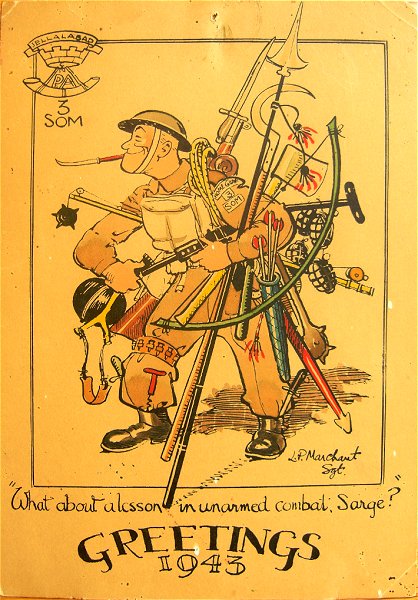
Courtesy of Yeovil Library
The actual role of the Home Guard was another matter. As seen by the War Office and the army, the Home Guard was to be a force akin to an armed police force but were to act in a passive role. In the event of an invasion it was expected that the Home Guard would act as observers and report enemy troop locations to the army. The Home Guard generally saw itself in a more active role - that of actually spearheading the fighting of an invasion force until the central army reserve arrived. Even in the planning stage of the country's defences it was anticipated that the Local Defence Volunteer force would play a part in assisting the Field Army. This role would involve, because of their inherent local knowledge, acting as guides and runners for the Army. They would also be responsible for maintaining stores and keeping defences such as section posts, communications trenches and weapons pits in good repair. It was also expected that the LDV would have a fighting role as and when necessary. The Home Guard were assigned to guard factories, airfields and other such prime targets, of which there were several in Yeovil, not least of which was Westlands which had its own Home Guard platoon. They also carried out nightly patrols, not just in the town of Yeovil itself, but across the countryside.
In 1940 there was much conjecture and speculation over the "Fifth Column" - a supposed subversive group in Britain supporting Germany and engaging in espionage or sabotage. This led to the setting up of numerous road blocks across the country, where the Home Guard would stop, question and check the identity cards all who wanted to pass through - often much to annoyance of the local population. Another fear, especially following the dropping of German Fällshirmjäger (paratroops) in Rotterdam and glider-borne troops in Belgium, was the threat of invasion by German paratroops that resulted in numerous Home Guard patrols spending countless days and nights throughout the war, watching the skies for parachutists. By 1941 the role of the Home Guard had been consolidated by outlining perceived threats and how the Home Guard would react to meet these threats.
The Secret Home Guard Operational Orders for the Yeovil Borough Company, referred to above, outlined the procedure to be taken in time of emergency as follows.
On receipt of the code word "ACTION STATIONS" the Yeovil Borough Company Home Guard will first parade as set out below and proceed therefrom to their respective stations. Dress to be full equipment and Great Coats.
Company HQ Section, No 1 Platoon and No 2 Platoon to parade at the Territorial Drill Hall in Southville, No 3 Platoon at the car park off South Street and No 4 Platoon at Far End House, Kingston. When the Company parade as detailed above, Platoon Commanders will immediately issue to all men in their Platoons who are issued with rifles, 60 rounds of .300 SAA (Small Arms Ammunition).
Sufficient ammunition for this purpose will be kept stored at the HQ of each Platoon and also at Summerhouse Hill Strong Point. A sufficient stock of picks, shovels and crowbars to allow a distribution of two picks, two shovels and two crowbars for each road block will also be stored at each Platoon HQ.
Immediately after the Company parade, Platoon Commanders will also draw from QM Stores, Territorial Drill Hall, Southville, the following ammunition :-
-
240 rounds of .300 SAA and twelve magazines for each Browning Rifle
-
550 rounds of .300 SAA for each Lewis Gun
-
50 rounds of 9mm ammunition for each Sten Gun
Other items to be issued included bombs, anti-tank mines, wire, sandbags, Northover mortars and other stores. The fact that picks, shovels and crowbars were allocated to each road block indicates that the blocks were simply temporary measures. However various types of road and rail blocks available to the Home Guard are discussed here.
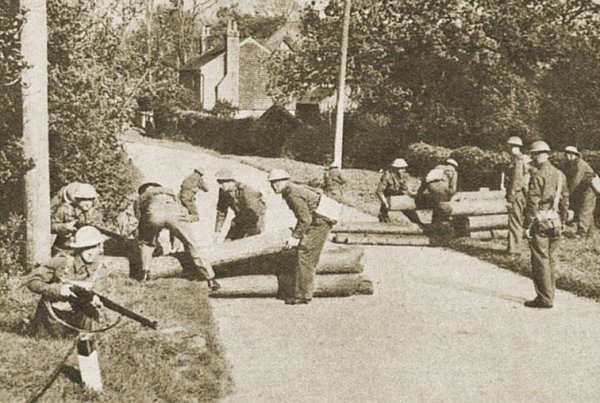
An early improvised road block (not in Yeovil) - checkpoints like these were a problem for the locals but little deterrent to a tank (Picture Post).
The instructions were that each man of the Home Guard parading on the code word "ACTION STATIONS" was to bring with him in his haversack sufficient food to last the first twelve hours. After the first twelve hours of duty further rations were to be distributed.
The orders directed that no roadblocks were to be erected until definite orders were issued by the Officer Commanding, Yeovil Anti-Tank Island, and all barriers erected had to be capable of removal within 10 minutes for the through passage of our own troops.
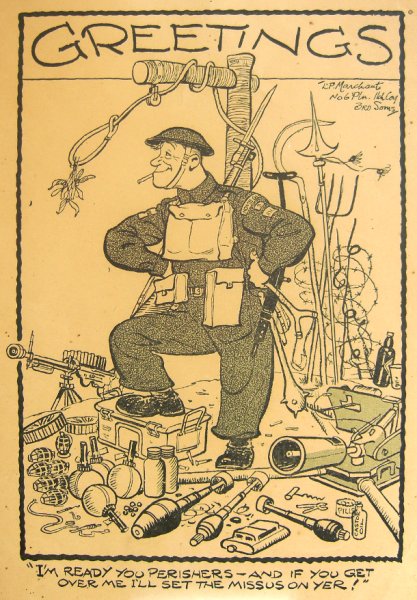
Courtesy of Yeovil Library
Even when the threat of invasion had passed, the Home Guard remained to give valuable service manning pillboxes and guard posts and carrying out a range of other duties that freed up regular troops for duties overseas. During 1942 the National Service Act allowed for compulsory enrolment where units were below strength. However following the successful invasion of France in June 1944 and the subsequent drive towards Germany by the allied armies, the Home Guard were formally stood down on 3 December 1944 and, finally, disbanded on 31 December 1945. My dad's Home Guard record states "Relinquished H.G. commission with effect from 31st December 1945, on the disbandment of the Home Guard. Granted the honorary rank of Lieutenant with effect from the same date, under authority of Army Order No. 32 of 1945".
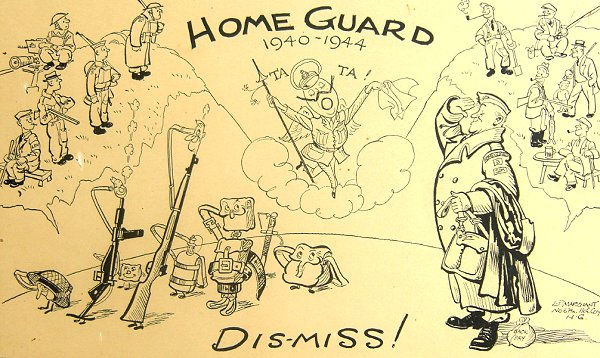
Courtesy of Yeovil Library
Winston Churchill said of the Home Guard "Such a force is of the highest value and importance. A country where every street and every village bristles with resolute, armed men is a country against which the tactics that destroyed the Dutch will not succeed.... a country so defended would not be liable to be overthrown."
However AJP Taylor in 'English History 1914-1945' said "The Home Guard harassed innocent citizens for their identity cards, put up primitive road-blocks, the traces of which may delight future archaeologists; and sometimes made bombs out of petrol tins. In a serious invasion, its members would presumably have been massacred if they had managed to assemble at all. Their spirit was willing though their equipment was scanty."
This particular debate will, perhaps, continue indefinitely.
gallery

Officers of 3rd Somerset (Yeovil) Battalion Home Guard, Yeovil Borough Company circa 1944.

Courtesy of Viv
Cafferkey
NCOs and other ranks of 3rd Somerset (Yeovil) Battalion Home Guard, Yeovil Borough Company circa 1944. Seventh from the left in the back row is Ben Thorne (thanks to Rob Baker) but can you name anyone else?

This photograph
features in my
book "A-Z
of Yeovil"
3rd
Somerset
(Yeovil)
Battalion
Home
Guard,
Yeovil
Borough
Company, Q
Section,
No 5
Platoon,
posing
with
their
2-pounder
anti-tank
gun
in
December
1944.
Back Row
-
Nutland,
Andrews,
Unknown
Middle
Row - J
Collins,
J Pilton,
Denmead,
Ben
Thorne,
McConnell,
Unknown,
Unknown,
J
Wilson,
Unknown,
P Moon,
E Ball,
J Snell.
Sitting
on gun -
S Eason
Front -
Unknown,
R
Sinnick

Courtesy
of Jack
Sweet
An unknown Yeovil Home Guard platoon. This colourised photograph was taken on the Petters Way Car Park. The houses behind were in Hendford - they were demolished and the site is now Dolphin House (the Job Centre).

Courtesy of
AgustaWestland
The Westland Home Guard on parade for the Duke of Kent in June 1941. The Duke died a year later, when his Sunderland crashed in Scotland.

Officers and Sergeants of Westlands Company
Front Row
- Paley,
Gibbons, Meadon,
Wilmont,
Unknown, Dowsett,
Clayton.
Second Row
- Sgt Chappel,
Lt Edward 'Ted' Frost,
Dodge, Capt GR
Turner, Major B
de la Perrelle,
Bex, Harrison,
Seymore,
Rowlands,
Unknown.
Third Row
- Unknown, Sgt
Pape, Sgt
Collie, Sgt
Petley, Sgt
Pilkington,
Unknown, Sgt
Watts, Sgt
Baker, Sgt
Hockey, Unknown,
Sgt Spilsbury,
Unknown.
Back Row
- Sgt Jones, Sgt
Loman, Sgt
Powell, Unknown,
Le Lohe, Sgt
Abbott, Sgt
Vickers, Sgt
Gardner,
Unknown.
Note the painted camouflage on the erecting shop in the background, attempting to make it look like residential buildings.

Courtesy of the
Old Yeovilians
Association Archive
A colourised photograph of HQ Westland Company, 3rd (Yeovil) Battalion, Somerset Home Guard, circa 1943. The photograph includes four 'Old Yeovilians' - front row, 2nd left Dennis Barnes, 3rd left Walter McGowan, 5th left Glen Hobday, 6th left David Freeman. Can you name anyone else?

Westlands Company, No 3 Platoon
Front Row
- L/Cpl Doug
Willis, C Ellen,
L/Cpl F Nash or
L/Cpl Lane, Tony
Yates, Unknown,
White, A White,
John Bush, B
Tetlow, Dennis
Lea.
Second Row
- Cpl J
Atkins, Unknown,
Sgt Frank Pape,
Sgt L Wiscomb
(Platoon
Sergeant), Lt
Paley, 2nd Lt
Ted Gibbons, Sgt
Collard, Sgt Bob
Collie, John
Edgeley, Cpl
Bill Williams.
Third Row
- Unknown,
Unknown, Jack
Perry (or J Brown
or J Sacker),
Ernie Hoskins,
Unknown, Legg,
Eric Ebsworth,
Curtis, Jack
Straw, W
Cousins.
Back Row
- Bob Walker, F
Folkard, J
Perrott,
Unknown, Basil
Garvey, Malgwyn
Edwards,
Unknown, G
Penny, Tony
Williams, Vic
Gardner.
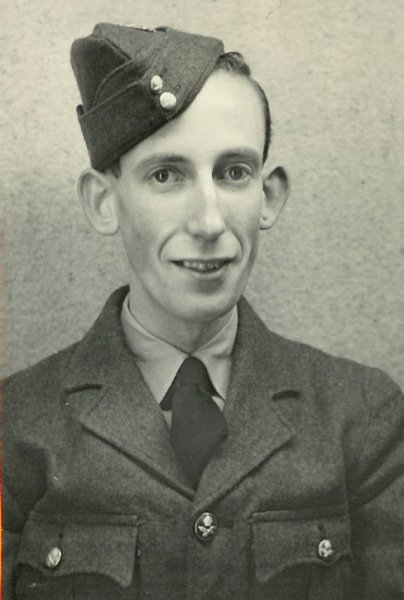
Courtesy of Ivor
Perry
Jack Perry (3rd row, 3rd from left in the above photo) photographed in 1946 - as he described it "just after accepting His Majesty's kind invitation to spend two years avoiding work in the RAF".

Courtesy of Lisa
Whitmarsh
A colourised photograph of an unknown platoon of the Westland Home Guard. Note the buildings in the background camouflaged to look like houses.
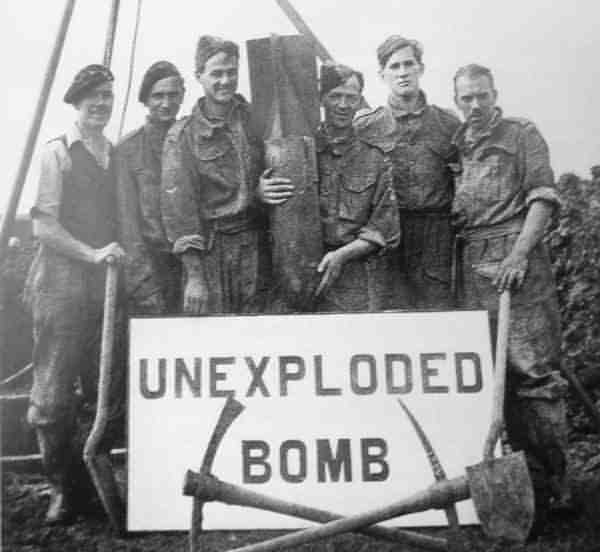
Men of the Westlands Bomb Disposal Unit pose with a German 50 kg bomb. The bomb was designated 'SC50' which stood for Sprengbombe Cylindrisch (English = cylindrical explosive bomb) and was a general-purpose high explosive bomb used by the Luftwaffe during the Second World War. A Heinkel 111 could carry up to 32 of these bombs.
For full details of the Westlands' Bomb Disposal Unit click here.
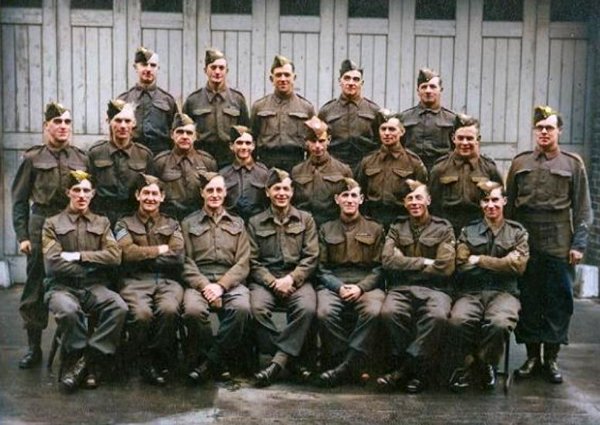
Courtesy of Rob
Baker
A colourised photograph of Yeovil Platoon "D" Company, 15th Gloucester (Post Office) Battalion of 1944.
Known members are - Ted Rossiter (middle row, far left), Donald McLean (middle row, 4th from left) and Bill Bussell (middle row, 2nd from right). Can you name anyone else?

The caption to this photograph read "Members of the Yeovil Home Guard burying explosives in the earth bank at Newton Road". In fact they were more likely to be constructing a favourite covert weapon of the Home Guard - a flame fougasse.

Courtesy of Rob
Baker
This photograph of the Yeovil Home Guard is undated, but judging by the array of weapons, is probably late 1943 or early 1944. The major weapons included in this photograph indicate conclusively that Yeovil was one of the better-equipped Home Guard Battalions. Enlarged sections of the photograph are show below.
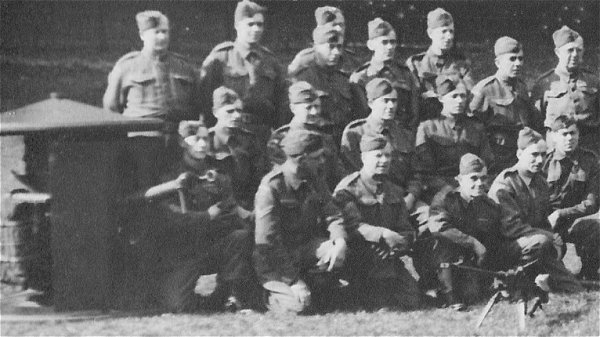
Courtesy of Rob
Baker
The left third of the above panoramic view shows a remarkable weapon - the Smith Gun - at left and a Boys Anti-Tank Rifle at right. Officially known as the Ordnance, Smooth Bore, 3 inch, or OSB, the Smith Gun was a weapon mostly issued to the Home Guard (in very small numbers) for anti-tank and HE purposes, although it was also occasionally used for airfield defence.

Courtesy of Rob
Baker
The middle third of the above panoramic view shows another remarkable weapon - a Blacker Bombard. The 29mm Spigot Mortar, also known as the Blacker Bombard after its inventor, Lieutenant-Colonel Stewart Blacker, was a stop-gap, close range anti-tank weapon approved by Winston Churchill in 1941 for use by the Home Guard.
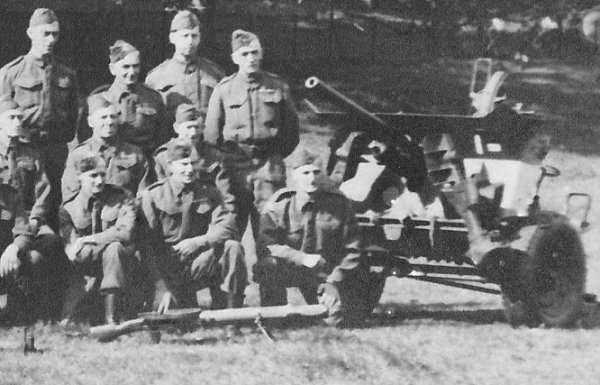
Courtesy of Rob
Baker
The right third of the above panoramic view shows two further Home Guard weapons, a Lewis Light Machine Gun and a 2-pounder Anti-Tank Gun. Following the defeat of the British Expeditionary Force in France, 2-pounder anti-tank guns were in desperately short supply in Britain since the BEF had left over 800 behind in France.

Courtesy
of
Yeovil
Library
List of equipment to be carried by each man in the Yeovil Borough Company Home Guard. Dated 17 March 1941, this document was signed by Major HCC Batten, Commander of Yeovil Borough Company Home Guard.

Courtesy
of Jack
Sweet
Yeovil Borough Company Home Guard parading at Southville, opposite the Drill Hall. The officer at bottom right is Lt W W Way, OC 4 Platoon. This is almost certainly the Stand Down parade on 3 December 1944.

Courtesy
of Jack
Sweet
Band Sergeant Chapman marches the Yeovil Borough Company Home Guard band down Lower Middle Street (outside the Railway Tavern at left). Again, this is the Stand Down parade on 3 December 1944.

Courtesy
of Rob
Baker
Stand down parades were held in every major Somerset town. Here members of the 3rd Somerset (Yeovil) Battalion Home Guard march through Yeovil on 3 December 1944.

From my
collection
The certificate of thanks presented to every person who served in the Home Guard (in this case, my dad).